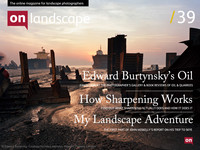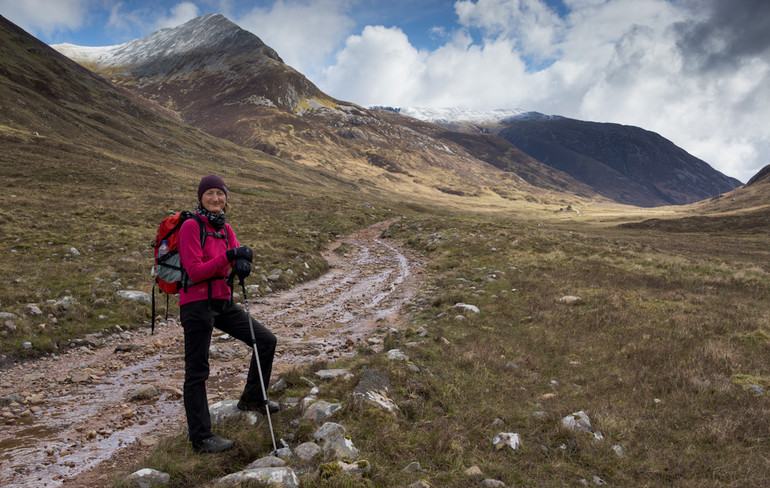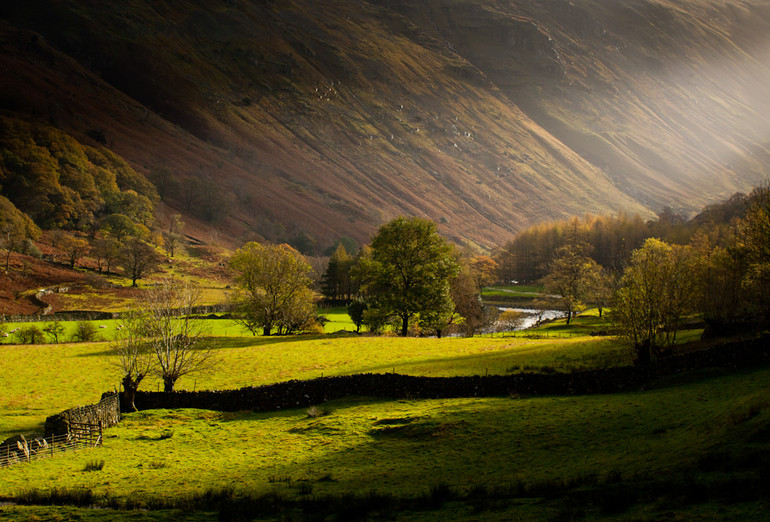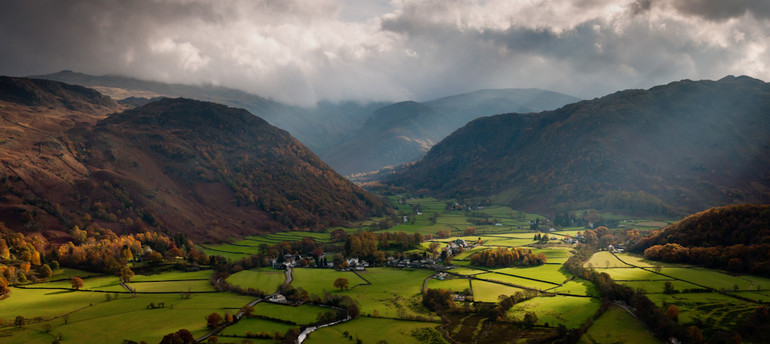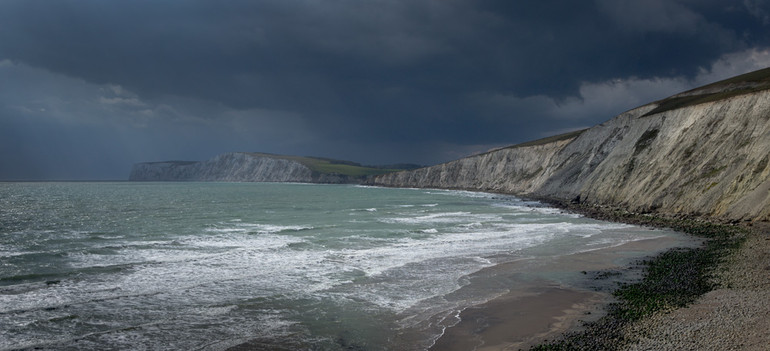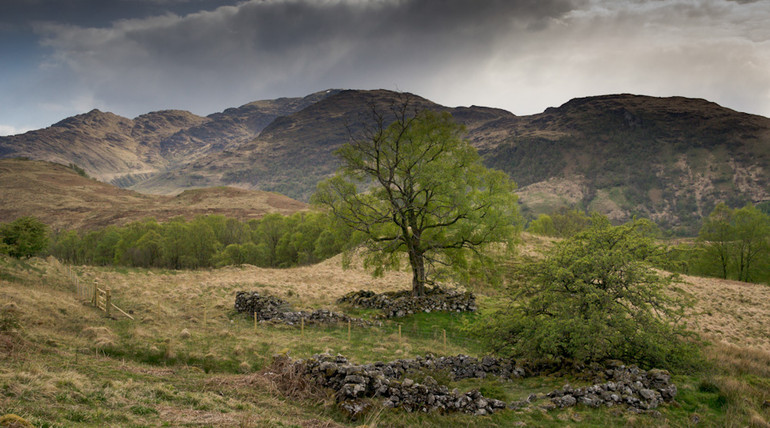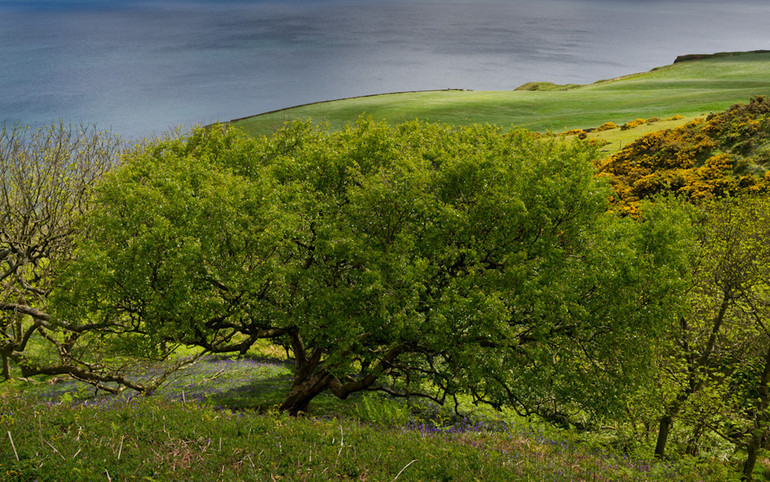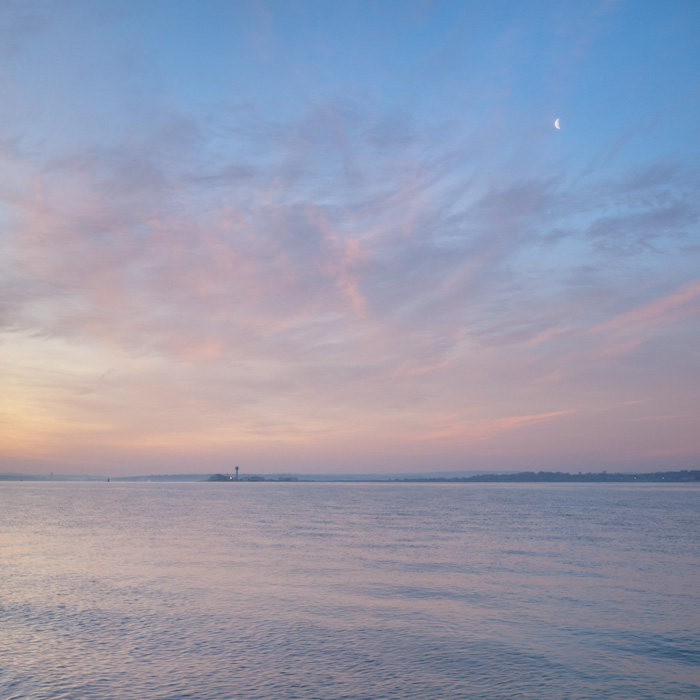Walking and serious Landscape Photography - an Oxymoron ?
The stereotypical view of the serious landscape photographer is one burdened with a large bag and a tripod. But for some notable exceptions (Galen Rowell immediately springs to mind) this view has not much changed from the beginnings of landscape photography to the modern day. While almost all things have progressively miniaturised the landscape photographers baggage seems to have defied that trend. Quality comes at a price in terms of the amount of equipment needed to cover the bases. Although the old contention that it is not about equipment is true I suggest that most readers of this site have a threshold of quality for their serious work (target 30x20in print) which rules out the camera phone/miniature compact (e.g. LX5, G12) as an option but for a small percentage of their work. Personally, if I go out on a 5mile+ walk or am engaged in a main non photographic activity (like walking the dog) then schlepping even a DSLR outfit becomes impractical and a tripod a non starter - ever tried throwing a ball with a backpack & tripod ? A secondary factor is that the increased popularity of landscape photography and the accessibility of 'honey pot' locations there is a desire to get off the beaten track to find and produce original work - this normally means walking.
In the last few years walking has become more and more important to me and, in addition to between 7 & 10miles per day with our dog, I have walked the Isle of Wight, Wainwright's Coast to Coast, the West Highland Way, parts of Offas Dyke and the Cleveland Way and will be undertaking the Tour De Mont Blanc later this year. Typical days are between 12 and 18 miles exceptionally up to 25miles. On all of the walking I have done I have frequently encountered wonderful scenery or exceptional lighting conditions that just must be captured . Most importantly, I would not have gone to these places as a photographic trip so the 5x4 or DSLR outfit would be at home and as we know the worst camera is the one left at home.... There are some well known exceptional photographers who do carry heavy weight kit on remote locations but it is not something you can casually do, no more so than fell running or the equivalent and it is not for me. As a consequence I have watched (and sampled) the development of high end miniature compacts and Compact System Cameras (CSCs) with great interest in search of a camera that can deliver 'serious' quality and be practical to carry.
How big is small ? Some learning points
1. A typical daypack for day or multi day (non camping) walk is 30-40litres in which there needs to be space for essential safety items, waterproofs, additional clothing, navigational aids (maps etc), food, a flask and water. This does not leave much physical space or headroom on weight before you need to increase the pack size (a big step) to maintain comfort.
2. From a mixture of observation and experience the camera needs to be packed but accessible without taking the pack off, if it is in the pack it stays in the pack and it is much too easy to walk on by a promising opportunity. I see quite a few walkers carrying a DSLR ' in hand' which is limiting over rough ground and also means both hands are full if you are using a pole, it always looks uncomfortable for any distance and cannot be safe.
3. A separate strapped bag, whether waist or shoulder, has not worked well for me. Another over the shoulder strap either digs in to your neck or is on the edge of the shoulder and is forever slipping off. A separate belt strap suffers a similar problem in contention with the waist strap of the day bag.
Nett of this is that a pouch (or pouches) on the belt of the rucksack is the best carrying option and really defines the size limits that the camera needs to meet. The pouch needs to be padded, weatherproof and not so heavy as to interfere with balance and integrity of the load distribution function of the belt system. I have found the Lowepro D-RES 10AW to be perfect for a basic kit.
Based on this, the limit is a small CSC and lenses, essentially ruling out any DSLR as a backpacking option. The good news is that CSCs are now at the point where quality is not compromised over a high end DSLR provided the principle that a CSC will not do everything but a DSLR could is accepted. If you only had one camera you would need to be pretty sure that this wasnt a problem.
What do I carry ?
My 'perfect' kit that enables me to do anything sensible while on the trail would be:
- Camera Body with spare battery and card.
- 3 high quality primes covering (in 35mm terms) 24mm, 35mm and 80mm.
- Graduated filter kit with 2 stop ND grad only & polariser.
- The camera must be usable in bright light as some models have viewing systems that are next to useless in bright sunshine.
Over the last 5 years my fulfilment of this requirement has changed and not always perfectly met. My own journey has led me to the following observations:
High End Miniature format Compacts
Typically these cameras have fixed zoom lens , a miniature sensor and importantly cost sub £500ukp. Examples are the Canon G12 and Panasonic LX5
This is where it all started for me with the Canon G10. I carried one everywhere for about a year and but for better options being available I would probably still be using it. The G concept hits the requirement for 'travel lite' exceptionally well with a good zoom range, Image Stabilisation that really works and a brick like robust construction. The LX-5 is similar in its capability but in a smaller package (IXUS sized) and almost shirt pocketable. These 2 models are the most popular amongst my Large Format friends notwithstanding other options being available which share the characteristics. Quality for on screen viewing and limited printing is excellent providing conditions are good. These high end compacts take an adapter that allows filter systems to be added and I found that the camera with filter kit installed could be stored comfortably in the DRes 10 and always be ready for action. I did find the quality of the files limiting in the end as a single portable solution, great for the screen but... .
Compact System Cameras
This area has seen the most development and a huge proliferation in models over the last 2 years. I wrote a short piece on the Panasonic GF-1 and Olympus EP-1 for this magazine in the first issue and how things have changed since then. The range of pricing is equally large with a small system costing anything from a few hundred pounds to several thousand. For the purposes of this debate I will exclude the Leica M9/10 and Fuji X-PRO. The XPRO is hugely expensive, undoubtedly capable of excellent results but no more than I would consider an M10 as a backpacking camera do I consider this to be in scope for now. Nikon and Pentax have now joined the field but with smaller sensors and as such sit somewhat uncomfortably for me in between High End Miniature Compacts and this group, a discussion for another day but for now I will also exclude them from this assessment ! YMMV.
From the mainstream players any model will likely meet the basic needs. From my own experience these are factors that were significant differentiators:
| Model Range | Olympus | Panasonic | Sony |
| Pros |
|
|
|
| Cons |
|
|
|
Oddballs
The new Canon G1-X conceptually could fall into the miniature category being of 'G' pedigree and ethos and may work well. It has a larger than m 4/3rds sensor but comes with a fixed zoom lens similar to the G12 in coverage. Similarly the Fuji X10 at significantly less money (but with well documented quality issues in its first iteration) should be considered but I have no experience of this or seen people using one to offer comment.
Miscellany
Batteries and battery life is worth a mention. I have never had an 'in day' problem with any digital camera providing I prepared properly the night before. That said I observe that cameras seem to be getting progressively worse on battery life. The G10 would go on forever and I never used the spare, the E-P1 was pretty good with no worries over a week of shooting and still having juice left. The Nex5n chews through batteries by comparison, I used 2 of the 3 batteries I took on the WHW changing the first at 30% and the second had 45% left after the eighth day. The Nex 7 seems hungrier still but I am still in the battery conditioning phase.
I have used the Lee RF75 filter system with all my compact cameras and still find it the best and most compact. Must get a polariser soon....
Two high end fixed focal length compacts are potential 'travel lite' cameras in the Fuji X100 and the Leica X1 (soon to be X2). The fact that better sensors are available in the CSC camp along with flexibility to change lenses is significant to get to an ideal kit. I did use a Leica X1 for a few months until the Summer and found it unusable in bright light (worse than the Olympus E-P1), sadly the X2 carries over the same screen but with the improved Sony sensor. Results should be outstanding as the X1 delivered the finest quality files of any 12mp camera I observed from that time period but at a significant financial cost.
Final Thoughts
I walked the Coast To Coast with a Panasonic Gf-1 and 20mm lens only. I was happy with the results but really missed the IS and lost a few shots to camera shake at surprisingly high shutter speeds. As a consequence I moved to the Olympus E-P1 with the 'in camera' IS and the Panasonic lenses. Hit rate improved significantly and I really fell in love with the colour from this camera. I was lucky enough to try a Sony Nex 5n at Christmas 2011 and was so completely bowled over by the results from this little camera that it has become my mainstay, it is in a different league from anything else digital I have played with over the years. The files have a very easy to get at 'light box' quality to them. I walked the West Highland Way in May with just the 24mm F1.8 Zeiss and the Nex 5n and came away feeling that I could not have got better with any other camera / lens combination. The lack of IS does not seem to be an issue as it was with the Panasonic, I suspect because the ergonomics are different and the lens balances perfectly in the palm of your hand. I have since added the newly available 50mm F1.8 and a Nex 7. Initial views on the Nex 7 is that there is a lot more detail but it does not zing like the 5n, the pixels feel a little constipated when trying to post process them !
So, to come back to the question posed at the beginning, I believe that the products now exist for uncompromised quality results from the latest batch of truly field portable cameras . Not 5x4 and not IQ180 as maybe but I find the prospect of walking the Alps for e.g as exciting photographically as for the walking and that is a good thing.
David Tolcher (http://www.davidtolcher.co.uk/)
- Figure 6: Raindale Leica X1
- Figure 1: Kinlochleven to Fort William. Nex 5n
- Figure 5: Nr Inverarnan Nex 5n
- Figure 4: Needles IOW Nex 5n
- Figure 2: Langstrath Dale Olympus E-P1
- Figure 7:Calshot Olympus E-P1
- Figure 3: Castle Crag Panasonic GF-1

